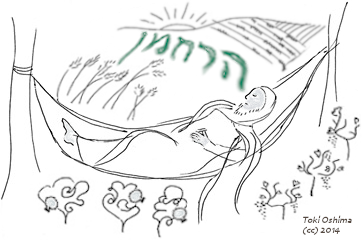by Rabbi David Seidenberg

As we approach Rosh Hashanah, we are also fast approaching the next Shmita year, when all the land in Israel was supposed to rest, all debts were supposed to be canceled, and all food was to be shared, even with the wild animals. Just like Elul through the High Holidays, the Shmita year itself was a long journey of t’shuvah, returning to God, during which our sense of business-as-usual could fall away, revealing what it means to be in community with each other and with the land. A human world that observed Shmita fully is a world that would never ruin Earth’s climate.
Before the last Shmita year (2014-2015), my friend Nili Simhai asked me to work up some Shmita year liturgy. The word Shmita means “release” and liberation, and the Shmita year is about three kinds of liberation: liberation among the people themselves, liberation between the people and the land, and release or liberation for the land itself. I wrote a Harachaman blessing that references all three, using three different verbs that have the root letters Shin ש and Bet ב, the same letters that are in t’shuvah.
Before sharing it, let me explain what a Harachaman blessing is. “Harachaman” means “the Merciful One,” a name for God, and it refers to a series of blessings and wishes for ourselves and the world, all of which begin with the word Harachaman, which we say at the end of the blessing after the meals, called in Hebrew Birkat Hamazon. So, for example, we pray “May the Merciful One let us inherit a world that is entirely filled with Shabbat” and “May the Merciful One renew for us a year that is good and sweet” for Shabbat and for Rosh Hashanah respectively.
Here then is the Harachaman that I wrote for Shmita:
May the merciful One turn our hearts toward the land,
so that we may dwell together with her in her sabbath-rest, the whole year of Shmita.
Harachaman hu yashiv libeinu el ha’aretz
l’ma’an neisheiv yachad imah b’shovtah, kol sh’nat hash’mitah!
הָרַחֲמָן הוּא יָשִיב לִבֵּינוּ אֶל הָאָרֶץ לְמַעַן נֵשֵב יָחַד עִמָהּ בְּשָׁבְתהּ, כָּל שְׁנַת הַשְׁמִיטָה
What are the three verbs connected to t’shuvah that relate to the levels of liberation?The first verb is yashiv (“turn our hearts toward the land”), and it comes from the word “turn”, lashuv, לשוב. It refers to our returning to a right relationship, on a heart level, with the Earth. Just as we ask God to turn us toward the divine intention in the verse Hashiveinu (“Turn us Hashem toward You”), here to we ask God to turn our hearts toward the land.
The second verb, neishev (“that we may dwell together”), comes from “settle” or “dwell”, lashevet, לשבת, as in shevet achim gam yachad – “how good it is for brothers and sisters to dwell together.” It refers to liberation between individuals in the year of release, when debts between people are canceled and food is shared with all, even with the wild animals.
The third verb, b’shovtah (“with her in her sabbath-rest”), comes from lishbot, לשבות, to rest, just like Shabbat, and it refers to the shabbat that the land itself enjoys in the Shmita year, as it says, “the land will enjoy her sabbaths” (Lev 26:43).
It is no accident that these three roots are connected to the same letters, since they are also connected on a soul-level with each other. They represent the true nature of tikkun olam. Tikkun, repair and restoration, must happen on all these levels together: turn back, settle down, rest. To fix the world, that must happen for the land, for the animals, and for the human beings, and that is what we are called to do in this Shmita year, as in every Shmita year to come.
A world that can learn Shmita might yet save us and turn us in t’shuvah toward choosing Life. May the Merciful let our turning come in time to avert the worst of climate disaster and to restore the health of the planet, along with her magnificent species that together make up the web of Life.
You are invited to download the Harachaman, and learn the song from Jonah Adels, z”l, that we sing it to, here: https://www.neohasid.org/resources/shmita-harachaman/
Rabbi David Seidenberg is the author of Kabbalah and Ecology: God’s Image in the More-Than-Human World, and the creator of neohasid.org. He has ordination from JTS and Reb Zalman, teaches on ecology, human rights, and animal rights in Judaism, leads astronomy programs, and is an avid dancer and musician.
